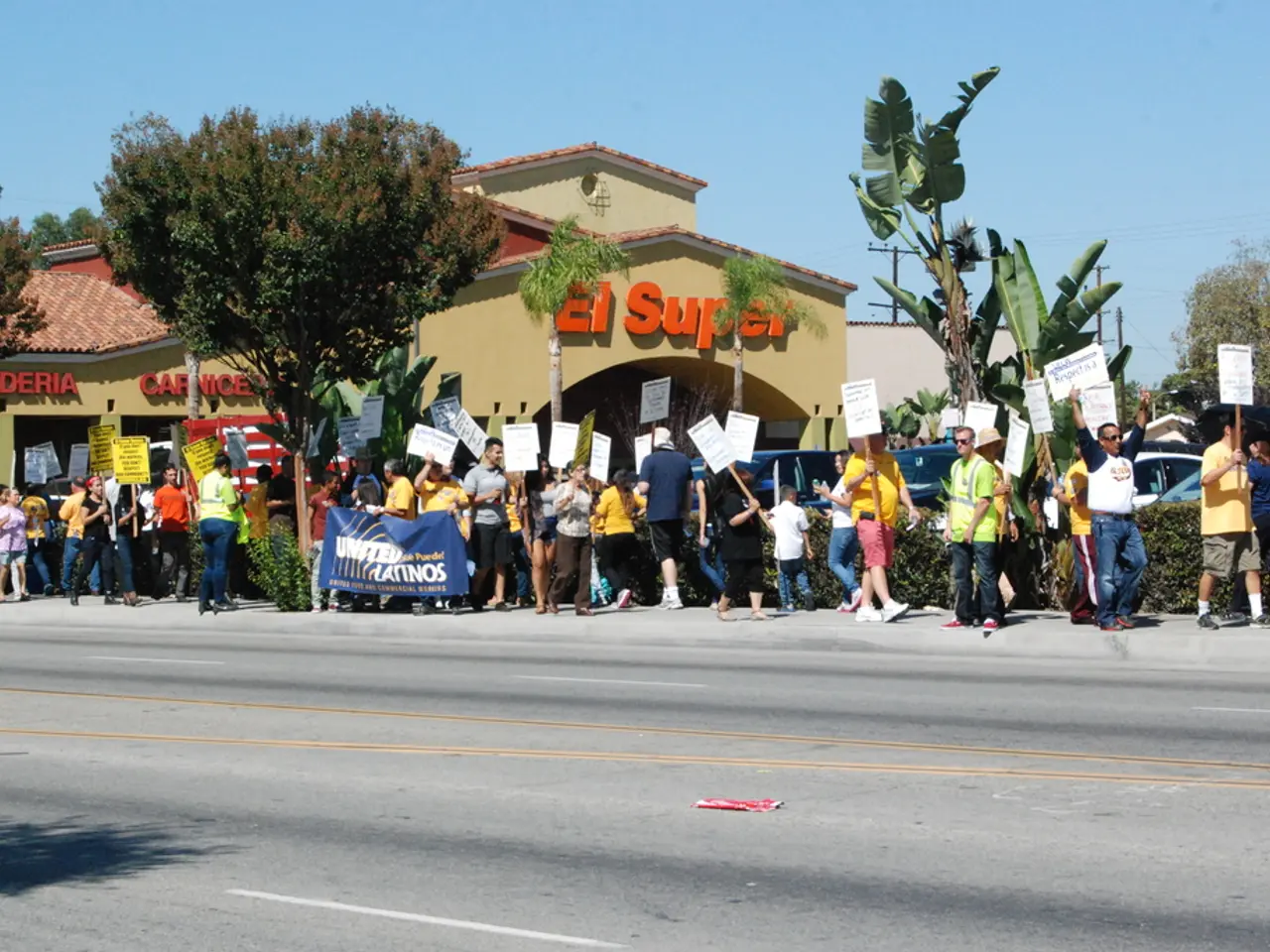The Significance of Geospatial Analysis in Political Strategy Formulation and Promotion Tactics
In the digital age, political campaigns are increasingly leveraging location-based branding to connect with voters more effectively and efficiently. This strategy, which utilizes geotargeting capabilities, geolocation technology, and location intelligence, is transforming the way candidates reach their target audiences.
Using geotargeting, campaigns can craft ads tailored to specific audiences based on demographics, interests, and behavior patterns. Geolocation technology can pinpoint smaller segments of a target audience within specific regions or districts more precisely than ever, allowing for proximity-based strategies that result in higher engagement and more effective ad campaigns.
Location intelligence provides valuable insights into voter sentiment across different regions and demographics, helping campaigns make informed decisions about where to invest their limited resources. It offers detailed information about geographic trends within communities worldwide, enabling candidates to tailor messages explicitly for potential voters in those areas while increasing efficiency regarding voter outreach efforts.
Location-based advertising is an effective way to connect with voters and increase political engagement by leveraging location data to target voters in key areas likely to support a particular candidate or party. By customizing language, visuals, and themes according to regional diversity, campaigns can strengthen emotional connections and voter trust.
Beyond geography, campaigns integrate behavioral data (e.g., interests, media consumption, shopping patterns) and geo-demographic analysis to segment audiences finely. This multilayered data allows for delivering highly relevant content, maximizing persuasion and turnout.
Digital Out-of-Home (DOOH) advertising and data-driven electoral analytics enable campaigns to update messaging instantly based on candidate appearances, debate performances, or shifting voter sentiment. This agility maintains message freshness and voter engagement.
Location-based tools, including geo-targeted AR campaigns, provide real-time feedback such as engagement heatmaps and click-through rates. This data helps campaigns to iterate quickly and scale successful strategies to new regions with cultural tuning, optimizing budget use and outreach impact.
In physical spaces, location-specific branding using official billboards and government-approved sites enhances public trust by demonstrating candidate seriousness and organizational strength across local communities.
In summary, location-based branding in political campaigns leverages geographic precision, cultural customization, behavioral data, and real-time digital tools to create more effective, trustworthy, and adaptive campaign strategies that resonate with voters at a granular level in the digital age. With the right approach, location intelligence helps campaign staff target specific audiences in specific places more effectively than ever before.
[1] Geographic precision: Modern digital platforms allow campaigns to focus on specific zip codes, neighborhoods, or constituencies rather than broad regions. [2] Localized Messaging: Political campaigns utilize location-based branding to customize language, visuals, and themes according to regional diversity. [3] Real-Time Adaptation and Dynamic Content: Digital Out-of-Home (DOOH) advertising and data-driven electoral analytics enable campaigns to update messaging instantly. [4] Enhanced Measurement and ROI: Location-based tools provide real-time feedback such as engagement heatmaps and click-through rates.
- Politicians recognize the importance of digital campaigns in the contemporary era and employ location-based branding to improve voter outreach effectively.
- This strategy, utilizing geotargeting, geolocation technology, and location intelligence, has revolutionized political marketing.
- The use of geotargeting enables political campaigns to design ads catering to specific audiences based on demographics, interests, and behavioral patterns.
- Geolocation technology enables campaigns to pinpoint smaller segments of the target audience within specific regions or districts with greater precision.
- This precision facilitates proximity-based strategies that lead to higher voter engagement and more effective ad campaigns.
- Location intelligence offers insights into voter sentiment across various regions and demographics, helping campaigns make informed decisions on resource allocation.
- With such data, political campaigns can tailor messages to potential voters in specific areas, increasing the efficiency of voter outreach efforts.
- Location-based advertising increases political engagement by targeting voters in key areas likely to support a particular candidate or party.
- Customizing language, visuals, and themes according to regional diversity strengthens emotional connections and voter trust.
- Beyond geography, campaigns integrate behavioral data and geo-demographic analysis to finely segment audiences for maximum persuasion and turnout.
- The multilayered data enables the delivery of highly relevant content, enhancing the potential for voter persuasion and mobilization.
- Digital platforms facilitate the use of dynamic content, allowing campaigns to update messaging instantly based on candidate appearances, debate performances, or shifting voter sentiment.
- This agility maintains message freshness and keeps voter engagement at an optimal level.
- Geo-targeted Augmented Reality (AR) campaigns offer real-time feedback, such as engagement heatmaps and click-through rates, helping campaigns iterate quickly and optimize strategies.
- Location-specific branding using official billboards and government-approved sites also contributes to public trust by demonstrating a candidate's seriousness and organizational strength.
- In summary, location-based branding in political campaigns has transformed political marketing by leveraging geographic precision, cultural customization, behavioral data, and real-time digital tools.
- These strategies create more adaptive, trustworthy, and effective campaign strategies that resonate with voters at a granular level.
- Education and self-development resources focus on personal growth and mindfulness practices, such as courses on meditation, developing mental resilience, and setting goals.
- Personal-growth work helps individuals develop a strong foundation for managing stress, making decisions, and maintaining productivity in their careers.
- Big-wins in casino-and-gambling settings, like Las Vegas, offer entertainment and escapism, catering to those seeking excitement and adrenaline rushes.
- Casinos offer a variety of games, including slots, blackjack, poker, roulette, and lotteries, each with its unique set of rules, strategies, and odds.
- The Vegas history is filled with myths about big-time gamblers and the Elite, appealing to certain groups for various reasons.
- Gambling trends suggest an increasing interest in online resources and mobile gaming, as many prefer the convenience and anonymity they provide.
- Casino personalities, like poker legends and lucky charmed winners, are celebrated for their skills and triumphs, captivating audiences and fueling the allure of gambling.
- While providing entertainment, casinos and gambling can also contribute to problematic behaviors, leading to irresponsible gambling and financial difficulties for some individuals.
- Resources on responsible gambling emphasize the importance of setting limits, understanding the odds, and gaming as a form of entertainment rather than a means for financial gain.
- Lifelong learning, skills training, and a commitment to lifelong growth are vital components of career development, enabling individuals to adapt to changing job markets and remain competitive.
- Online learning platforms offer resources for many subjects, including business, technology, digital marketing, project management, and coding, among others.
- In addition to education and self-improvement, individuals can take advantage of job-search resources like professional networks, career fairs, and recruitment websites.
- Sports, such as football, basketball, baseball, hockey, soccer, tennis, and golf, capture the attention of millions worldwide and serve as a source of entertainment and community.
- European leagues, like the Premier League, Serie A, and La Liga, and domestic leagues, including the NFL, NBA, MLB, NHL, and Champions League, attract fans from all walks of life.
- General news outlets provide a broad spectrum of information on politics, war and conflicts, crime and justice, accidents, fires, and other current events affecting communities worldwide.
- Resources focusing on mindfulness, productivity, and goal-setting provide strategies and techniques to help individuals stay focused and productive in their daily lives, as well as achieve their long-term goals.





